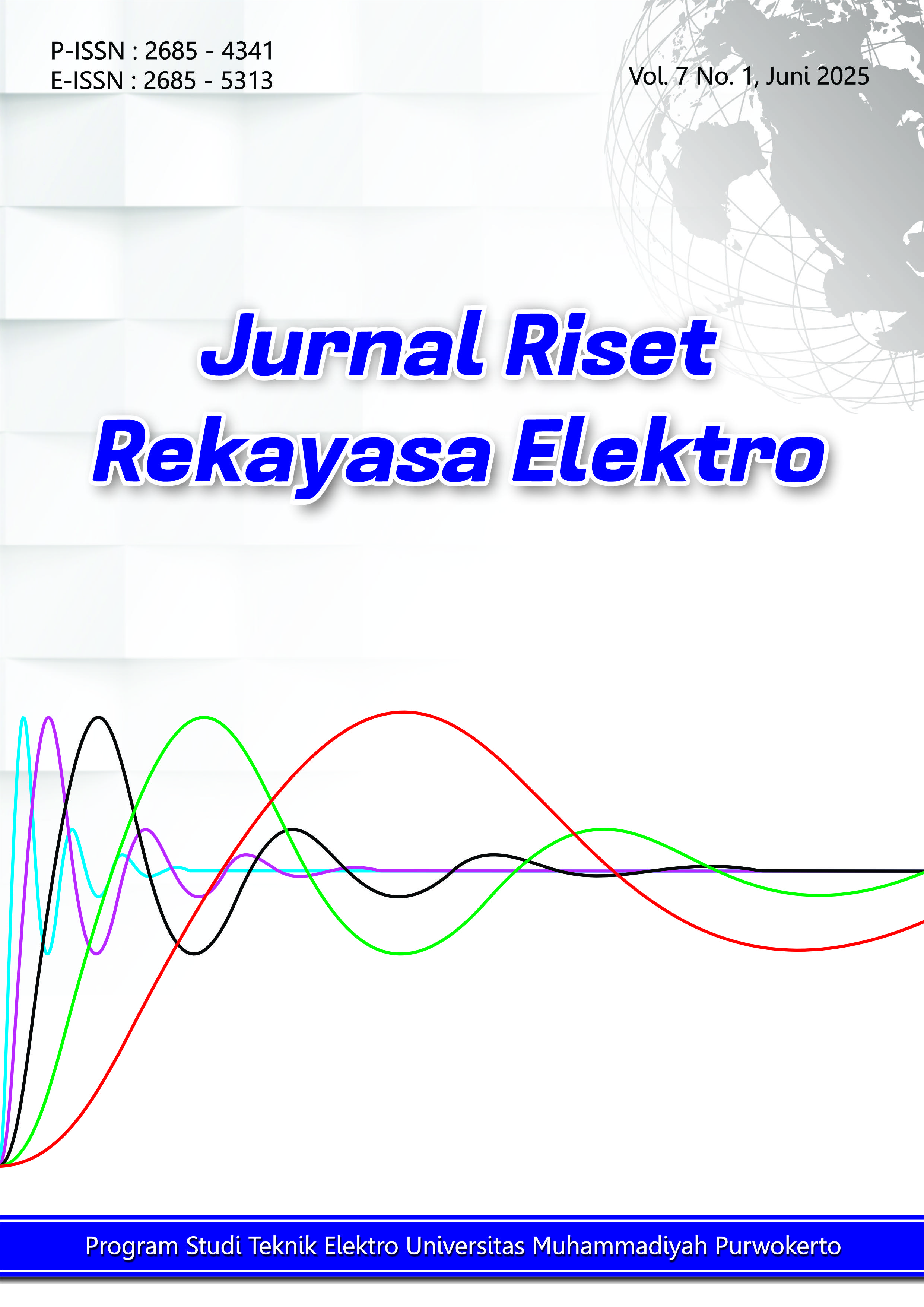Perancangan dan Pemodelan PLTS Off-Grid dengan Penyimpanan Energi Hibrida Berbasis Superkapasitor-Baterai: Studi Kasus di Desa Karamina, Papua
DOI:
https://doi.org/10.30595/jrre.v7i1.26325Keywords:
Energi Terbarukan, Solar PV, Penyimpanan Energi, Superkapasitor, BateraiAbstract
Desa Karamina di Papua merupakan wilayah terpencil yang belum terjangkau jaringan listrik PLN. Penelitian ini bertujuan merancang dan memodelkan sistem Pembangkit Listrik Tenaga Surya (PLTS) off-grid dengan penyimpanan energi hibrida berbasis superkapasitor dan baterai. Simulasi dilakukan menggunakan MATLAB dan Simulink untuk mengevaluasi kinerja sistem terhadap variasi radiasi matahari, perubahan beban, serta kondisi inrush current. Hasil menunjukkan bahwa sistem mampu menjaga kestabilan tegangan dan arus pada kondisi dinamis. Superkapasitor efektif meredam fluktuasi daya dan mengurangi arus riak pada baterai, sehingga memperpanjang umur baterai. Integrasi superkapasitor-baterai dalam sistem PLTS off-grid memberikan solusi andal dan efisien untuk elektrifikasi daerah terpencil seperti Desa Karamina.
References
[1] N. M. Haegel and S. R. Kurtz, “Global Progress Toward Renewable Electricity: Tracking the Role of Solar (Version 2),” IEEE J Photovolt, vol. 12, no. 6, pp. 1265–1272, 2022, doi: 10.1109/JPHOTOV.2022.3206532.
[2] B. Chegari, M. Tabaa, E. Simeu, and M. El Ganaoui, “Optimal energy management of a hybrid system composed of PV, Wind turbine, pumped hydropower storage and battery storage to achieve a complete energy self-sufficiency in residential buildings,” IEEE Access, vol. 12, no. September, pp. 126624–126639, 2024, doi: 10.1109/ACCESS.2024.3454149.
[3] J. T. Bialasiewicz, “Renewable energy systems with photovoltaic power generators: Operation and modeling,” IEEE Transactions on Industrial Electronics, vol. 55, no. 7, pp. 2752–2758, 2008, doi: 10.1109/TIE.2008.920583.
[4] S. Ganesan, U. Subramaniam, A. A. Ghodke, R. M. Elavarasan, K. Raju, and M. S. Bhaskar, “Investigation on sizing of voltage source for a battery energy storage system in microgrid with renewable energy sources,” IEEE Access, vol. 8, pp. 188861–188874, 2020, doi: 10.1109/ACCESS.2020.3030729.
[5] F. R. Albogamy et al., “Real-Time Scheduling for Optimal Energy Optimization in Smart Grid Integrated with Renewable Energy Sources,” IEEE Access, vol. 10, pp. 35498–35520, 2022, doi: 10.1109/ACCESS.2022.3161845.
[6] R. Raff, V. Golub, D. Topic, G. Knezevic, and J. Perok, “Optimization of the off-grid systems based on renewable energy for power supply in rural areas,” International Conference on the European Energy Market, EEM, vol. 2019-Septe, 2019, doi: 10.1109/EEM.2019.8916573.
[7] J. O. Oladigbolu, M. A. M. Ramli, and Y. A. Al-Turki, “Feasibility study and comparative analysis of hybrid renewable power system for off-grid rural electrification in a typical remote village located in Nigeria,” IEEE Access, vol. 8, pp. 171643–171663, 2020, doi: 10.1109/ACCESS.2020.3024676.
[8] B. Hachim, D. Dahlioui, and A. Barhdadi, “Electrification of rural and arid areas by solar energy applications case study: Boumhaout village in south of Morocco,” Proceedings of 2018 6th International Renewable and Sustainable Energy Conference, IRSEC 2018, pp. 1–4, 2018, doi: 10.1109/IRSEC.2018.8702978.
[9] A. Zaharim et al., “Public acceptance on stand-alone renewable energy project in rural area of Malaysia,” Energy and Sustainability in Small Developing Economies, ES2DE 2017 - Proceedings, 2017, doi: 10.1109/ES2DE.2017.8015349.
[10] F. Bartyzel and P. Ocłón, “Simulation software for design improvement,” 2023 8th International Conference on Smart and Sustainable Technologies, SpliTech 2023, p. 10193173, 2023, doi: 10.23919/SpliTech58164.2023.10193173.
[11] M. I. Hossain, M. Tanvir Islam Mim, T. Banik, M. R. Jany, M. Mukter Hossain Emon, and A. Shufian, “Decentralized Solar PV/Battery-based Energy Management for Isolated Areas,” 2024 IEEE 3rd International Conference on Robotics, Automation, Artificial-Intelligence and Internet-of-Things, RAAICON 2024 - Proceedings, pp. 188–193, 2024, doi: 10.1109/RAAICON64172.2024.10928452.
[12] M. F. Elmorshedy, M. R. Elkadeem, K. M. Kotb, I. B. M. Taha, and D. Mazzeo, “Optimal design and energy management of an isolated fully renewable energy system integrating batteries and supercapacitors,” Energy Convers Manag, vol. 245, no. July, p. 114584, 2021, doi: 10.1016/j.enconman.2021.114584.
[13] H. W. Yan et al., “Battery Lifetime Extension in a Stand-Alone Microgrid with Flexible Power Point Tracking of Photovoltaic System,” IEEE J Emerg Sel Top Power Electron, vol. 11, no. 2, pp. 2281–2290, 2023, doi: 10.1109/JESTPE.2022.3212702.
[14] R. Alfanz, A. Nugraha, M. Otong, M. F. Haekal, W. Martiningsih, and M. F. Fauzy, “Design and Development of An Automatic Energy Buffer System and Hybrid Energy Storage on PV System Using Supercapacitors,” 2024 International Conference on Informatics Electrical and Electronics, ICIEE 2024 - Proceedings, p. 2024, 2024, doi: 10.1109/ICIEE63403.2024.10920392.
[15] B. Ihsan, D. Sahidin, T. D. Rachmildha, and D. Hamdani, “Peningkatan Umur Baterai pada PLTS Off-grid menggunakan Penyimpanan Energi Hibrida Berbasis,” vol. 05, no. 2, pp. 77–84, 2024.
[16] B. Ihsan, “Perancangan Dan Analisis Sistem PV Off-Grid Dengan Sistem Hybrid Energy Storage,” Thesis, Sekolah Teknik Elektro dan Informatika, Institut Teknologi Bandung, 2021.
[17] B. Ihsan, A. Matthee, F. Leferink, T. D. Rachmilda, and D. Hamdani, “Active Transient EMI Stabilization,” Asia Pacific International Symposium on Electromagnetic Compatibility, p. 2021, 2021.
Downloads
Published
How to Cite
Issue
Section
License
Copyright (c) 2025 Jurnal Riset Rekayasa Elektro

This work is licensed under a Creative Commons Attribution 4.0 International License.
Authors who publish with this journal agree to the following terms:
Authors retain copyright and grant the journal right of first publication with the work simultaneously licensed under a Creative Commons Attribution License that allows others to share the work with an acknowledgement of the work's authorship and initial publication in this journal.
Authors are able to enter into separate, additional contractual arrangements for the non-exclusive distribution of the journal's published version of the work (e.g., post it to an institutional repository or publish it in a book), with an acknowledgement of its initial publication in this journal.
Authors are permitted and encouraged to post their work online (e.g., in institutional repositories or on their website) prior to and during the submission process, as it can lead to productive exchanges, as well as earlier and greater citation of published work (See The Effect of Open Access).

Jurnal Riset Rekayasa Elektro is licensed under a Creative Commons Attribution 4.0 International License.




